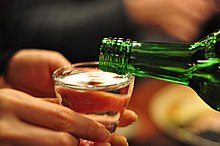 Pouring soju into a soju glass | |
| Type | Spirit |
|---|---|
| Country of origin | Goryeo, now Korea |
| Region of origin | Gaegyeong |
| Color | Clear |
| Ingredients | Distilled ethanol, sweeteners, flavorings |
| Related products | baijiu, shōchū |
Soju (/ˈsoʊdʒuː/; Korean: 소주; Hanja: 燒酒) is a clear and colorless distilled alcoholic beverage,[1][2][3] traditionally made from rice, but later from other grains and has a flavor similar to vodka.[4] It is usually consumed neat. Its alcohol content varies from about 12.5% to 53% alcohol by volume (ABV), although since 2007 low alcohol soju below 20% has become more popular.[5][6]
Traditionally, most brands of soju are produced in the Andong region, but also in other regions and countries. While soju was traditionally made from rice, South Korean ethanol producers replace rice with other starch, such as cassava due to significantly lower capital costs. Soju often appears similar to several other East Asian liquors while differing in alcohol contents.[7]
- ^ "soju". Oxford Dictionary of English. Oxford University Press. Archived from the original on May 17, 2019. Retrieved April 14, 2017.
- ^ "soju". Merriam-Webster Dictionary. Encyclopædia Britannica. Archived from the original on July 5, 2017. Retrieved November 22, 2014.
- ^ Miller, Norman (December 2, 2013). "Soju: the most popular beverage in the world". The Guardian. Retrieved April 13, 2017.
- ^ Wolinski, Cat (August 29, 2018). "The Differences Between Soju, Shochu, and Sake, Explained". VinePair.
- ^ Park, Eun-jee (November 19, 2014). "Koreans looking for weaker soju". Korea JoongAng Daily. Archived from the original on April 14, 2017. Retrieved April 14, 2017.
- ^ Hall, Joshua (October 17, 2014). "Soju Makers Aim to Turn Fire Water Into Liquid Gold". The Wall Street Journal. Archived from the original on April 15, 2017. Retrieved December 24, 2014.
- ^ Wolinski, Cat (August 29, 2018). "The Differences Between Soju, Shochu, and Sake, Explained". VinePair. Archived from the original on March 24, 2022. Retrieved March 30, 2022.